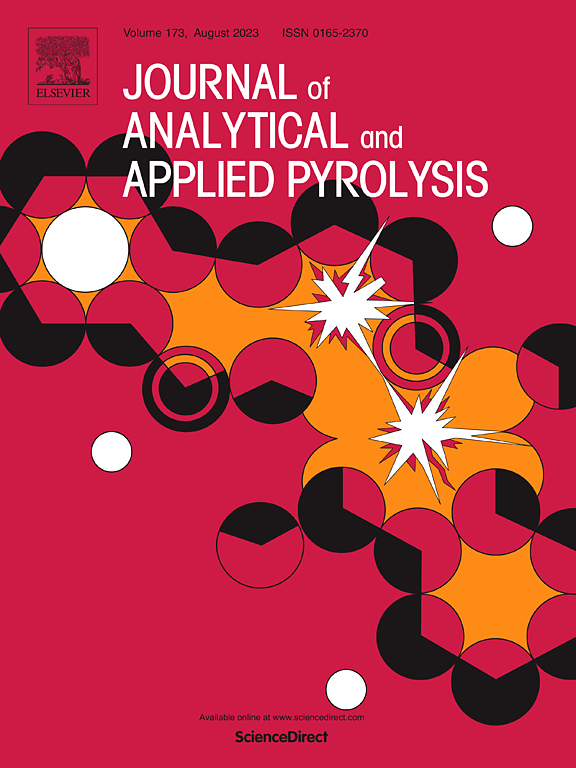Micro-Raman spectroscopy and Petrography for unraveling the complex heterogeneous physicochemical structures of biochar from the scale of bulk to micro: A comparison and discussion
IF 5.8
2区 化学
Q1 CHEMISTRY, ANALYTICAL
引用次数: 0
Abstract
This study produced biochar from coconut shells and corncobs through pyrolysis under a nitrogen atmosphere with temperatures ranging from 350℃ to 1400℃. The surface regions of the biochar were characterized at the micro-scale using a combination of micro-Raman spectroscopy and petrography. Extensive data from both methods were compared and correlated from the scale of bulk to micro- levels. The results indicate that for bulk structures, the average random reflectance (Rf) increases and Raman parameter α decreases with temperature, indicating a higher thermal maturity and lower C-H, C-O etc. structures. However, AD/AG, A(VR+VL+GR)/AD and A(VR+VL+GR)/AG exhibit significant inflection points at specific temperatures. These inflection points are linked to key structural transformations: aromatization at 600 ℃ and graphitization at 1000 ℃. At microscale, biochar contains pores of varying shapes and sizes (approximately 5–100μm) with ash deposits embedded within them. These features significantly influence the heterogeneity in Rf measurements, resulting in a broaden distribution of Rf as the pyrolysis process progressed. Besides, micro-Raman spectroscopy shows that biochar particles with higher substituent and side-chain abundances have a tendency towards preferential reactivity. Furthermore, the chemical structural distribution of biochar became more concentrated and focused below 1000 ℃. However, biochar undergoes heterogeneous graphitization at 1000 ℃, and the distribution of aromatic rings and graphite structure becomes even more dispersed between 1000 ℃-1400 ℃. The correlations between the results of petrographic method and micro-Raman at the bulk and micro-scale have been set up and discussed, and it can provide guidance for the comprehensive characterization of the heterogeneous structure of biochar.
这项研究利用椰子壳和玉米芯在氮气环境下进行热解,温度范围为 350℃ 至 1400℃,从而生产出生物炭。研究人员采用显微拉曼光谱法和岩相法对生物炭的表面区域进行了微观表征。对这两种方法获得的大量数据进行了比较,并将这些数据从块状尺度到微观尺度进行了关联。结果表明,对于块状结构,平均随机反射率(Rf)随温度升高而增加,拉曼参数α随温度升高而降低,这表明热成熟度较高,C-H、C-O 等结构较低。然而,AD/AG、A(VR+VL+GR)/AD 和 A(VR+VL+GR)/AG 在特定温度下会出现明显的拐点。这些拐点与关键的结构转变有关:600 ℃ 时的芳香化和 1000 ℃ 时的石墨化。在微观尺度上,生物炭含有形状和大小不一的孔隙(约 5-100μm),孔隙中蕴藏着灰分沉积物。这些特征极大地影响了 Rf 测量的异质性,导致 Rf 分布随着热解过程的进行而扩大。此外,显微拉曼光谱显示,取代基和侧链丰度较高的生物炭颗粒具有优先反应性倾向。此外,生物炭的化学结构分布在 1000 ℃ 以下更加集中。然而,生物炭在 1000 ℃ 时发生了异质石墨化,芳香环和石墨结构的分布在 1000 ℃-1400 ℃ 之间变得更加分散。建立并讨论了岩相法和显微拉曼法在体积尺度和微观尺度上的相关性,可为生物炭异质结构的综合表征提供指导。
本文章由计算机程序翻译,如有差异,请以英文原文为准。
求助全文
约1分钟内获得全文
求助全文
来源期刊
CiteScore
9.10
自引率
11.70%
发文量
340
审稿时长
44 days
期刊介绍:
The Journal of Analytical and Applied Pyrolysis (JAAP) is devoted to the publication of papers dealing with innovative applications of pyrolysis processes, the characterization of products related to pyrolysis reactions, and investigations of reaction mechanism. To be considered by JAAP, a manuscript should present significant progress in these topics. The novelty must be satisfactorily argued in the cover letter. A manuscript with a cover letter to the editor not addressing the novelty is likely to be rejected without review.

 求助内容:
求助内容: 应助结果提醒方式:
应助结果提醒方式:


